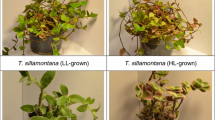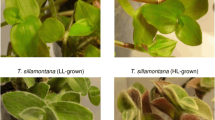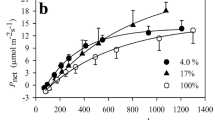Abstract
When intact green leaves are exposed to the fluctuating light, in which high light (HL) and low light (LL) alternate, photosystem I (PSI) is readily damaged. This PSI inhibition is mostly alleviated by the addition of far-red (FR) light. Here, we grew Alocasia odora, a shade-tolerant species, at several light levels and examined their photosynthetic traits in relation to the fluctuating light-induced PSI inhibition. We found that, even in the absence of FR, PSI in LL-grown leaves was resistant to the fluctuating light. LL leaves showed higher chlorophyll (Chl) contents on leaf area basis, lower Chl a/b ratios, lower cytochrome f/P700 ratios, and lower PSII/PSI excitation ratios assessed by the 77 K fluorescence. Also, P700 in the HL phase of the fluctuating light was more oxidized. The results of the regression analyses of the PSI photoinhibition to these traits indicate that the lower electron flow rate to P700 and more excitation energy transfer to PSI protect PSI in LL-grown leaves. Both of these contribute oxidization of P700 to the efficient quencher form P700+. These features may be common in LL-grown shade-tolerant species, which are often exposed to strong sunflecks in their natural habitats.









Similar content being viewed by others
Abbreviations
- CEF-PSI:
-
Cyclic electron flow around PSI
- FL:
-
Fluctuating light
- FR:
-
Far-red
- HL:
-
High light
- LED:
-
Light-emitting diode
- LL:
-
Low light
- PPFD:
-
Photosynthetic photon flux density
- Y(I):
-
Effective quantum yield of PSI
- Y(II):
-
Effective quantum yield of PSII
- Y(NA):
-
Acceptor-side limitation of PSI
- Y(ND):
-
Donor-side limitation of P700
References
Alboresi A, Storti M, Morosinotto T (2018) Balancing protection and efficiency in the regulation of photosynthetic electron transport across plant evolution. New Phytol 221:105–109. https://doi.org/10.1111/nph.15372
Anderson JM (1986) Photoregulation of the composition, function, and structure of thylakoid membranes. Annu Rev Plant Physiol 37:93–136. https://doi.org/10.1146/annurev.pp.37.060186.000521
Anderson JM, Aro EM (1993) Grana stacking and protection of Photosystem II in thylakoid membranes of higher plant leaves under sustained high irradiance: an hypothesis. Photosynth Res 41:315–326. https://doi.org/10.1007/BF00019409
Barth C, Krause GH, Winter K (2001) Responses of photosystem I compared with pososystem II to high-light stress in tropical shade and sun leaves. Plant Cell Environ 24:163–176. https://doi.org/10.1111/j.1365-3040.2001.00673.x
Björkman O (1981) Responses to different quantum flux densities. In: Lange OK, Nobel PS, Osmond CB, Ziegler H (eds) Encyclopedia of plant physiology, new series, vol 12A. Springer, Berlin, pp 57–106
Björkman O, Demmig B (1987) Photon yield of O2 evolution and chlorophyll fluorescence characteristics at 77 K among vascular plants of diverse origins. Planta 170:489–504. https://doi.org/10.1007/BF00402983
Boardman NK (1977) Comparative photosynthesis of sun and shade plants. Annu Rev Plant Physiol 28:355–377. https://doi.org/10.1146/annurev.pp.28.060177.002035
Bos I, Bland KM, Tian L, Croce R, Frankeo LK, van Amerongen H, Bricker TM, Wientjes E (2017) Multiple LHCII antennae can transfer energy efficiently to a single photosystem I. Biochim Biophys Acta 1858:371–378. https://doi.org/10.1016/j.bbabio.2017.02.012
Chow WS, Qian L, Goodchild DJ, Anderson JM (1988) Photosynthetic acclimation of Alocasia macrorrhiza (L. ) G. Don Austral J Plant Physiol 15:107–122. https://doi.org/10.1071/PP9880107
Flannery SE, Hepworth C, Wood WHJ, Pastrelli F, Hunter CN, Dickman MJ, Jackson PJ (2020) Developmental acclimation of the thylakoid proteome to light intensity in Arabidopsis. Plant J. https://doi.org/10.1111/tpj.15053
Genty B, Briantais JM, Baker NR (1989) The relationship between the quantum yield of photosynthetic electron transport and quenching of chlorophyll fluorescence. Biochim Biophys Acta 990:87–92. https://doi.org/10.1016/S0304-4165(89)80016-9
Havaux M, Davaud A (1994) Photoinhibition of photosynthesis in chilled potato leaves is not correalted with a loss of photosysytem-II activity: preferential inactivation of photosystem I. Photosynth Res 40:75–92. https://doi.org/10.1007/BF00019047
Hikosaka K, Tersahima I (1995) A model of the acclimation of photosynthesis in the leaves of C3 plants to sun and shade with respect to nitrogen use. Plant Cell Environ 18:615–618. https://doi.org/10.1111/j.1365-3040.1995.tb00562.x
Hikosaka K, Terashima I (1996) Nitrogen partitioning among photosynthetic components and its consequences in sun and shade plants. Funct Ecol 10:335–343. https://doi.org/10.2307/2390281
Inoue K, Sakurai H, Hiyama T (1986) Photoinactivation sites of photosystem I in isolated chloroplasts. Plant Cell Physiol 27:962–968. https://doi.org/10.1093/oxfordjournals.pcp.a077213
Izawa S (1980) Acceptors and donors and chloroplast electron transport. Method Enzymol 69:413–434. https://doi.org/10.1016/S0076-6879(80)69041-7
Karapetyan NN (2008) Protective dissipation of excess absorbed energy by photosynthetic apparatus of cyanobacteria: role of antenna terminal emitters. Photosynth Res 97:195–204
Kim E, Watanabe A, Duffy CDP, Ruban AV, Minagawa J (2020) Multimeric and monomeric photosystem II supercomplexes represent structural adaptations to low-and high-light conditions. J Biol Chem 295:14537–14545. https://doi.org/10.1074/jbc.RA120.014198
Klughammer C, Schreiber U (1994) An improved method, using saturating light-pulses, for the determination of photosystem-I quantum yield via P700+-absorbency changes at 830 nm. Planta 192:261–268. https://doi.org/10.1007/BF00194461
Kanda Y (2013) Investigation of the freely available easy-to-use software ‘EZR’ for medical statistics. Bone Marrow Tanspl 48:452–458. https://doi.org/10.1038/bmt.2012.244
Kono M, Terashima I (2014) Long-term and short-term responses of the photosynthetic electron transport to fluctuating light. J Photochem Photobiol B 137:89–99. https://doi.org/10.1016/j.jphotobiol.2014.02.016
Kono M, Terashima I (2016) Elucidation of photoprotective mechanisms of PSI against fluctuating light photoinhibition. Plant Cell Physiol 57:1405–1414. https://doi.org/10.1093/pcp/pcw103
Kono M, Noguchi K, Terashima I (2014) Roles of the cyclic electron flow around PSI (CEF-PSI) and O2-dependent alternative pathways in regulation of the photosynthetic electron flow in short-term fluctuating light in Arabidopsis thaliana. Plant Cell Physiol 55:990–1004. https://doi.org/10.1093/pcp/pcu033
Kono M, Yamori W, Suzuki Y, Terashima I (2017) Photoprotection of PSI by far-red light against the fluctuating light-induced photoinhibition in Arabidopsis thaliana and field-grown plants. Plant Cell Physiol 58:35–45. https://doi.org/10.1093/pcp/pcw215
Kono M, Kawaguchi H, Mizusawa N, Yamori W, Suzuki Y, Terashima I (2020) Far-red light accelerates photosynthesis in the low-light phases of fluctuating light. Plant Cell Physiol 61:192–202. https://doi.org/10.1093/pcp/pcz211
Kudoh H, Sonoke K (2002) Irreversible damage to photosystem I by chilling in the light: cause of the degradation of chlorophyll after returning to normal growth temperature. Planta 215:541–548. https://doi.org/10.1007/s00425-002-0790-9
Li L, Aro EM, Miller AH (2018) Mechanisms of photodamage and protein turnover in photoinhibition. Trend Plant Sci 23:667–676. https://doi.org/10.1016/j.tplants.2018.05.004
Miyake C (2020) Molecular mechanisms of oxidation of P700 and suppression of ROS production in photosystem I in response to electron-sink limitations in C3 plants. Antioxidants 9:230. https://doi.org/10.3390/antiox9030230
Miyata K, Noguchi K, Terashima I (2012) Cost and benefit of the repair of photodamaged photosystem II in spinach leaves: roles of acclimation to growth light. Photosynth Res 113:165–180. https://doi.org/10.1007/s11120-012-9767-0
Miyata K, Ikeda H, Nakaji M, Kanel DR, Terashima I (2015) Rate constants of PSII photoinhibition and its repair, and PSII fluorescence parameters in the field plants in relation to their growth light environments. Plant Cell Physiol 56:1841–1854. https://doi.org/10.1093/pcp/pcv107
Murata N, Nishiyama Y (2018) ATP is a dribing force in the repair of photosytem II during photoinhibition. Plant Cell Environ 41:285–299. https://doi.org/10.1111/pce.13108
Munekage Y, Hashimoto M, Miyake C, Tomizawa K, Endo T, Tasaka M, Shikanai T (2004) Cyclic electron flow around photosystem I is essential for photosynthesis. Nature 429:579–582. https://doi.org/10.5511/plantbiotechnology.22.361
Noguchi K, Taylor NL, Miller AH, Lambers H, Day DA (2005) Response of mitochondria to light intensity in the leaves of sun and shade species. Plant Cell Environ 28:760–771. https://doi.org/10.1111/j.1365-3040.2005.01322.x
Öquist G, Greer DH, Ögren E (1987) Light stress at low temperature. In: Kyle DJ, Osmond CB, Arntzen CJ (eds) Photoinhibition, pp. 67–87, Elsevier, Amsterdam. ISBN-13: 978-0444808905
Pearcy RW (1990) Sunflecks and photosynthesis in plant canopies. Annu Rev Plant Physiol Plant Mol Biol 41:421–453. https://doi.org/10.1146/annurev.pp.41.060190.002225
Porra RJ, Thompson WA, Kriedemann PE (1989) Determination of accurate extinction coefficients and simultaneous equations for assaying chlorophylls a and b extracted with four different solvents: verification of the concentration of chlorophyll standards by atomic absorption spectroscopy. Biochim Biophys Acta 975:384–394. https://doi.org/10.1016/S0005-2728(89)80347-0
Powles S (1984) Photoinhibition of photosynthesis induced by visible light. Ann Rev Plant Physiol 35:15–44. https://doi.org/10.1146/annurev.pp.35.060184.000311
Rutherford AW, Osyczka A, Rappaport F (2012) Back-reactions, short-circuits, leaks and other energy wasteful reactions in biological electron transfer: redox tuning to survive life in O2. FEBS Lett 586:603–616. https://doi.org/10.1016/j.febslet.2011.12.039
Satoh K (1970a) Mechanisms of photoinactivation inphotsynthetic systems. I. The dark reaction in photoinactivation. Plant Cell Physiol 11:15–27. https://doi.org/10.1093/oxfordjournals.pcp.a074487
Satoh K (1970b) Mechanisms of photoinactivation inphotsynthetic systems. II. The occurrence and properties of two different types of photoinactivation. Plant Cell Physiol 11:29–38. https://doi.org/10.1093/oxfordjournals.pcp.a074493
Satoh K (1970c) Mechanisms of photoinactivation inphotsynthetic systems. III. Site and mode of phoinactivation in photosystem I. Plant Cell Physiol 11:187–197. https://doi.org/10.1093/oxfordjournals.pcp.a074500
Satoh K, Fork DC (1982) Photoinhibition of reaction centers of photosystems I and II in intact Bryopsis chloroplasts under anaerobic conditions. Plant Physio 70:1004–1008. https://doi.org/10.1104/pp.70.4.1004
Schöttler MA, Tóth SZ (2014) Photosynthetic complex stoichiometry dynamicsin higher plants: environmental acclimation and photosynthetic flux control. Front Plant Sci 5:188. https://doi.org/10.3389/fpls.2014.00188
Schreiber U (2017) Redox changes of ferredoxin, P700, and plastocyanin measured simultaneously in intact leaves. Photosynth Res 134:343–360. https://doi.org/10.1007/s11120-017-0394-7
Sejima T, Takagi D, Fukayama H, Makino A, Miyake C (2014) Repetitive short-pulse light mainlyy inactivates photosystem I in sunflower leaves. Plant Cell Physiol 55:1184–1193. https://doi.org/10.1093/pcp/pcu061
Shimakawa G, Miyake C (2018) Oxidation of P700 ensures robust photosynthesis. Front Plant Sci 9:1617. https://doi.org/10.3389/fpls.2018.01617
Sonoike K (1996) Degradation of psaB gene product, the reaction center subunit of photosystem I, is caused during photoinhibition of photosystem I: possible involvement of active oxygen species. Plant Sci 115:157–164. https://doi.org/10.1016/0168-9452(96)04341-5
Sonoike K (2011) Photoinhibition of photosystem I. Physiol Plant 142:56–64. https://doi.org/10.1111/j.1399-3054.2010.01437.x
Sonoike K, Terashima I (1994) Mechanism of photosystem-I photoinhibition in leaves of Cucumis sativus L. Planta 194:287–293. https://doi.org/10.1007/BF01101690
Sonoike K, Terashima I, Iwaki M, Itoh S (1995) Destruction of photosystem iron-sulfur centers in leaves of Cucumis sativus L. by weak illuminatio at chilling temperatures. FEBS Lett. 362:235–238. https://doi.org/10.1016/0014-5793(95)00254-7
Stefanov D, Terashima I (2008) Non-photochemical loss in PSII in high- and low-light-grown leaves of Vicia faba quantified by several fluorescence parameters including LNP, a novel parameter. Physiol Plant 133:327–338. https://doi.org/10.1111/j.1399-3054.2008.01077.x
Suorsa M, Jarvi S, Grieco M, Nurmi M, Pietrzykowska M, Rantala M, Kangasjärvi S, Paakkarinen V, Tikkanen M, Jansson S, Aro EM (2012) PROTON GRADIENT REGULATION5 is essential for proper acclimation of Arabidopsis photosystem I to naturally and artificially fluctuating light conditions. Plant Cell 24:2934–2948. https://doi.org/10.1105/tpc.112.097162
Takagi D, Takumi S, Hashiguchi M, Sejima T, Miyake C (2016) Superoxide and singlet oxygen produced within the thylakoid membranes both cause photosystem I photoinhibition. Plant Physiol 171:1626–1634. https://doi.org/10.1104/pp.16.00246
Takagi D, Ihara H, Takumi S, Miyake C (2019) Growth light environment changes the sensitivity of photosystem I photoinhibition depending on common wheat cultivars. Front Plant Sci 10:686. https://doi.org/10.3389/fpls.2019.00686
Terashima I, Funayama S, Sonoike K (1994) The site of photoinhibition in leaves of Cucumis sativus L. at low temperatures is photosysytem I, not photosystem II. Planta 193:300–306. https://doi.org/10.1007/BF00192544
Tsuyama M, Kobayashi Y (2009) Reduction of the primary donor P700 of photosystem I during steady-state photosynthesis under low light in Arabidopsis. Photosynth Res 99:37–47. https://doi.org/10.1007/s11120-008-9379-x
Tikkanen M, Griecon M, Kangasjärvi S, Aro EM (2010) Thylakoid protein phosphorylatin in higher plant chloroplasts optimizes electron transfer under fluctuating light. Plant Physiol 152:723–735. https://doi.org/10.1104/pp.109.150250
Tiwari A, Mamedov F, Grieco M, Soursa M, Jajoo A, Styring S, Tikkanen M, Aro EM (2016) Photodamage of iron-sulphur clusters in photosystem I induces non-photochemical energy dissipation. Nature Plants 2:1–9. https://doi.org/10.1038/NPLANTS.2016.35
Trissl HW (1997) Determination of the quenching efficiency of the oxidized primary donor of Photosystem I, P700+: implications for the trapping mechanisms. Photosynth Res 54:237–240. https://doi.org/10.1023/A:1005981016835
Yamamoto H, Shikanai T (2019) PGR5-dependent cyclic electron flow protects photosystem I under fluctuating light at donor and acceptor sides. Plant Physiol 179:588–600. https://doi.org/10.1104/pp.18.01343
Yamori W (2016) Photosynthetic response to fluctuating environments and photoprotective strategies under abiotic stress. J Plant Res 129:379–395. https://doi.org/10.1007/s10265-016-0816-1
Yokono M, Murakami A, Akinomot S (2015) A mega-complex composed of both photosystem reaction centres in higher plants. Nat Commun 6:6675. https://doi.org/10.1038/ncomms7675
Yokono M, Takabayashi A, Kishimoto J, Fujita T, Iwai M, Murakami A, Akinomoto S, Tanaka A (2019) The PSI-PSII megacomplex in green plants. Plant Cell Physiol 60:1098–1108. https://doi.org/10.1093/pcp/pcz026
Zavafer A, Iermak I, Cheah MH, Chow WS (2019) Two quenchers formed during photodamage of Phostosystem II and the role of one quencher in preemptive photoprotection. Sci Rep 9:17275. https://doi.org/10.1038/s41598-019-53030-7
Zivcak M, Brestic M, Kunderlikova K, Sytar O, Allakhverdiev SI (2015) Repetitive light pulse-induced photoinhibition of photosystem I severely affects CO2 assimilation and photoprotection in wheat leaves. Photosynth Res 126:449–463. https://doi.org/10.1007/s11120-015-0121-1
Acknowledgements
We thank Professor S. Akimoto for helpful discussions. We are analyzing chlorophyll protein complexes with Drs. A. Watanabe, E. Kim and R. Tokutsu and Professor J. Minagawa (National Institute for Basic Biology, Okazaki, Jalan). We also thank anonymous reviewers and the editor, Dr. Alonso Zavafer, for critical comments. IT knows Professor W.S. Chow since 1985 and would like to sincerely celebrate his great academic achievement. IT is honoured to have published several papers including one in this special issue with Professor Chow and Dr. R. Oguchi.
Funding
This work was partly supported by Japan Society for the Promotion of Science (JSPP) KAKENHI grants to IT (17H05718 and 19H04718).
Author information
Authors and Affiliations
Corresponding author
Ethics declarations
Conflict of interest
The authors declare no conflicts of interest associated with this manuscript.
Additional information
Publisher's Note
Springer Nature remains neutral with regard to jurisdictional claims in published maps and institutional affiliations.
Supplementary Information
Below is the link to the electronic supplementary material.
Rights and permissions
About this article
Cite this article
Terashima, I., Matsuo, M., Suzuki, Y. et al. Photosystem I in low light-grown leaves of Alocasia odora, a shade-tolerant plant, is resistant to fluctuating light-induced photoinhibition. Photosynth Res 149, 69–82 (2021). https://doi.org/10.1007/s11120-021-00832-4
Received:
Accepted:
Published:
Issue Date:
DOI: https://doi.org/10.1007/s11120-021-00832-4




